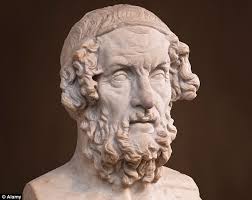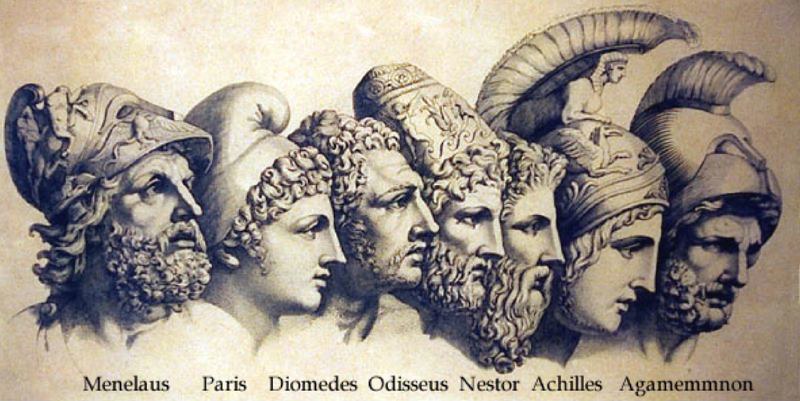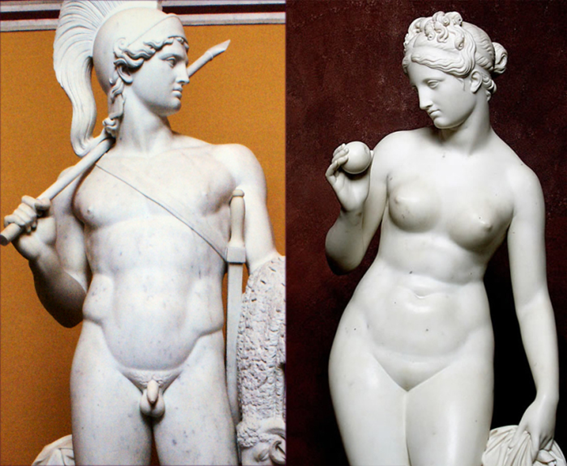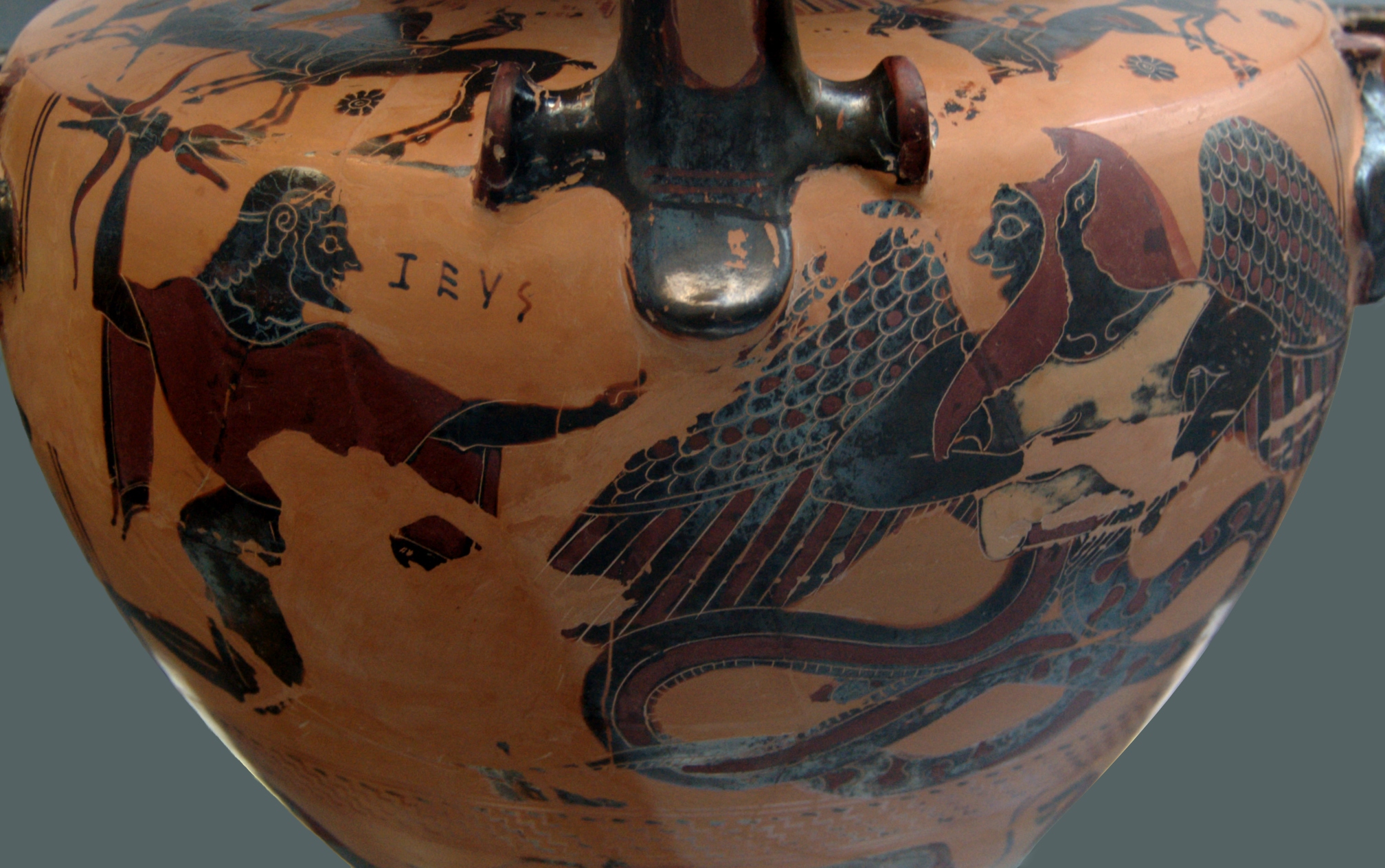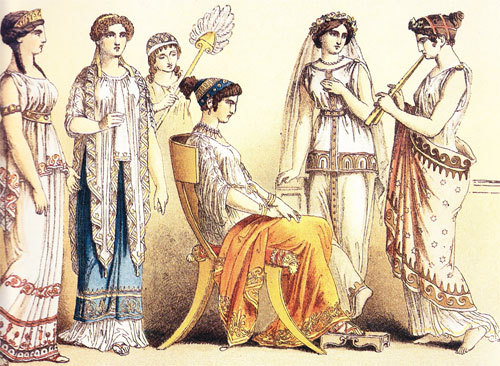Were the Greeks blond and blue-eyed?
In 2013 I translated this article from the Spanish blogsite Evropa Soberana in fragmented form. Now that I am reviewing The Fair Race’s Darkest Hour for the 2015 edition, I would like to see it reproduced here in a single entry:
I remember a movie that came out in 2004. Troy was called. Naturally, many fans of Greece went to see it quite interested; some of them because they sincerely admired Hellas and its legacy. But some uncultivated specimens attended the theaters too. Everyone knows that, in our day, Greece is regarded as a mark of snobbery and sophistication even though you do not know who Orion was, or what was the color of Achilles’ hair according to mythology. The movie’s Helen (one with a look of a neighborhood slut) and Achilles (Brad Pitt) were rather cute. Adding the special effects, advertising and usual movie attendance there was no reason not to see this movie that, incidentally, is crap except for a few redeemable moments.
Upon first glance at the big screen, one of the many reactions that could be heard from the mouth of alleged scholarly individuals, was something like the following:
Outrageous: Achilles and Helen, blond and blue-eyed! Oh tragedy! Oh tantrum! Such a huge stupidity! Irreparable affront! It is obvious that Nazism, fascism, Nordicism, Francoism, anti-Semitism, homophobia and sexism are booming in Hollywood, because who would have the crazy notion to represent the Greeks as blond, when their phenotype was Mediterranean? Only the Americans could be so uneducated and egocentric and ethnocentric and Eurocentric and fascists and Nazis and blah blah…
These good people were not outraged by the desecration of The Iliad; for the absurd and fallacious script, for representing Achilles like an Australian surfer, or Helen as a cunt or the great kings as truckers of a brothel. No. They didn’t give a hoot about that. What mattered was leaving very clearly that they were sophisticated people, conscious of what was happening and that, besides being progressive democrats and international multi-culturalists without blemish, and able to pronounce “phenotype” without binding the tongue, they were also sufficiently “sincere admirers of Greece” to be indignant and losing their monocles before a blond Achilles.
The same could be said about the ultra-educated reaction to the movie 300. When it was released, we could see an outraged mass (and when we say “outraged” we are saying really outraged) complaining in the most grotesque way, by the presence here and there, of blond Spartans throughout the movie—fascist xenophobia by Hollywood and the like. How easy it is for the big mouths when there are large doses of daring ignorance involved, and when they have no idea what it stands to reason.
What I did not expect was to hear similar statements from the admirers of classical culture: people that one generously assumes they have read the Greco-Roman works or that are minimally informed—at least enough to not put one’s foot in it in a such a loudly manner. For Achilles, considered the greatest warrior of all time, and sole and exclusive holder of the holy anger, is described in The Iliad as blond, along with an overwhelming proportion of heroes, heroines, gods, goddesses—and even slaves considered desirable and worthy for the harem of the Greek warriors to seed the world with good genes.
The same could be said of the Spartans if we consider the physical appearance of their northern Dorian ancestors, who had come “among the snows” according to Herodotus. In fact, the movie 300 was too generous with the number of Spartans of dark hair, and too stingy with the number of blonds.
Whoever declares himself an admirer of classical European culture (Greece and Rome) and, at the same time, asserts that it was founded by swarthy, Mediterraneans-like-me folks is placing himself in the most uncomfortable form of self-consciousness. As I have said, if such individual really admired the classical world and bothered to read the classical works, he would have ascertained to what extent Nordic blood prevailed in the leaders of both Greece and Rome—especially in Greece. In short, those who claim being ultra-fans of Greece, Rome or both only throw garbage on themselves by demonstrating that they had not even read the original writings.
There are many truths about Nordic blood and Hellas but perhaps the most eloquent and overwhelming truth is that Greek literature is full of references to the appearance of the heroes and gods because the Greeks liked to place adjectives on all the characters, and nicknames and epithets representing their presence. So much so that it is really hard to find a swarthy character. In the case, for example, of Pindar, it is a real scandal: there is not a single character that is not “blonde,” “golden,” “white,” “of snowy arms,” and therefore “godlike.”
The blue eyes were described as γλαυκώπισ (glaukopis), which derives from γλαῦκος (glaukos), “brilliant,” “shiny.” The Roman writer Aulus Gellius, in his Attic Nights describes the concept of colors in a conversation between a Greek and a Roman. The Roman tells the Greek that glaucum (from which derives the Castilian glaucous) means gray-blue, and the Greek translates glaukopis into Latin as caesia, “sky,” i.e., sky blue. As Günther observes, the very word “iris,” of Greek origin, that describes the color of the eye, could only have been chosen by a people whom clear and bright eye colors dominated (blue, green or gray), and that a predominately swarthy people would have never compared the eye color with the image of the rainbow.
The Greek word for blond was ξανθός (xanthus), “yellow,” “gold,” “blond.” The xanthus color in the hair, as well as extreme beauty, light skin, high height, athletic build and luminous eyes were considered by the Greeks as proof of divine descent.
The physical appearance of Greek gods and heroes
 Demeter as it was conceived by the Greeks. We must remember that the statues had a deeply sacred and religious character for the Hellenes and that, in addition of being works of art, they were also the height of geometric feeling and engineering, since the balance had to be perfect. The Greeks, who had a great knowledge of the analyses of features, represented in their statues not only beautiful people, but beautiful people with a necessarily beautiful soul.
Demeter as it was conceived by the Greeks. We must remember that the statues had a deeply sacred and religious character for the Hellenes and that, in addition of being works of art, they were also the height of geometric feeling and engineering, since the balance had to be perfect. The Greeks, who had a great knowledge of the analyses of features, represented in their statues not only beautiful people, but beautiful people with a necessarily beautiful soul.
There is a persistent tendency among the Hellenes to describe their idols as “dazzling,” “radiant,” “shiny,” “bright,” “full of light,” etc., something that very obviously correspond to a barely pigmented, “Nordic” appearance. To be more direct, I’ll omit these ambiguous quotes and focus on the concrete: the specific references to the color of skin, eyes, hair, and more. Where possible I’ve inserted the works, specific chapters and verses so that anyone can refer to the original passage.
• Demeter is described as “the blonde Demeter” in The Iliad (Song V: 500) and in Hymn to Demeter (I: 302), based on the mysteries of Eleusis. It is generally considered a matriarchal and telluric goddess from the East and of the pre-Indo-European peoples of Greece. However, here we should be inclined to think that, at best, she was a Europeanized goddess by the Greeks, integrated into their pantheon. The very name of Demeter comes from Dea Mater (Mother Goddess) and therefore would, in a sense, be the counterpart of Deus Pater—Zeus Pater or Jupiter, Dyaus Piter.
• Persephone, daughter of Demeter, is described as “white-armed” by Hesiod (Theogony: 913). At least it is clear here that Persephone was not a brown skinned goddess, nor that her physique coincided with the “Mediterranean” type. It is more reasonable to assume that her appearance was, at best, predominantly Nordic.
• Athena, the daughter of Zeus, goddess of wisdom, insight, cunning and strategic warfare in The Iliad, is described no more no less than a total of 57 times as “blue eyed” (in some variations, “green eyed”), and in The Odyssey a comparable number of times. Pindar referred to her as xanthus and glaukopis, meaning “blonde, blue-eyed.” Hesiod is content to call her “of green eyes” in his Theogony (15, 573, 587, 890 and 924), as well as Alcaeus and Simonides; while the Roman Ovid, in his Metamorphoses, which tells the perdition of Arachne, calls the goddess “manly and blond maiden.”
• Hera, the heavenly wife of Zeus, is called “white-armed” by Hesiod (Theogony, 315), while Homer called her “of snowy arms” and “white-armed goddess” at least thirteen times in The Iliad (I: 55, 195, 208, 572. 595, III 121, V: 775, 784; VIII: 350, 381, 484; XV: 78, 130).
• Zephyrus, the progenitor of Eros along with Iris, is described by Alcaeus (VII-VI centuries BCE) as “golden hair Zephyr” (Hymn to Eros, fragment V, 327).
• Eros, the god of eroticism, considered “the most terrible of the gods,” is described by an unknown, archaic Greek author as “golden-haired Eros.”

• Apollo as it was conceived by the very Greek sculptors. We are talking about a Nordic-white racial type slightly Armenized. Along with Athena, he was the most worshiped god throughout Greece, and particularly loved in Sparta.
Apollo is described by Alcaeus as “fair-haired Phoebus.” Phoebus is Apollo. On the other hand, Alcman of Sparta, Simonides (paean to Delos, 84), and an anonymous author, call Apollo “of golden hair,” while another epithet of his by Góngora—a Spanish author of the Renaissance but based on classic literary evidence—is “blond archpoet.” The famous Sappho of Lesbos speaks of “golden-haired Phoebus” in her hymn to Artemis.
• The god Rhadamanthus, son of Zeus and Europa, is described as blond in The Odyssey, and Strabo calls him “the blond Rhadamanthus” in his Geographica (Book III, 11-13).
• Dionysus is called by Hesiod “golden-haired” (Theogony 947).
• Hecate, goddess of the wilderness and also of the Parthians, is described by an unknown Greek poet as “golden haired Hecate, daughter of Zeus.”

• Artemis (illustration), the sister of Apollo is described by Sappho and Anacreon (Hymn to Artemis) as “blond daughter of Zeus.”
• The goddess Thetis, mother of Achilles, is called by Hesiod “of silver feet” (Theogony 1007), and by Homer “of silvery feet” (Iliad, I: 538, 556, IX : 410; XVI : 574, XVIII : 369, 381, XIV:89). Needless to say that a brown-skinned woman cannot have silvery feet: this is an attribute of extremely pale women.
• The Eunice and Hipponoe mermaids are described as “rosy-armed” by Hesiod (Theogony, ll. 240-264).
• Aphrodite, daughter of Zeus, goddess of love, beauty and female eroticism, is always described as a blonde. Its conventional title is almost always “Golden Aphrodite.” Ibycus (in Ode to Polycrates) calls Aphrodite “Cypris of blond hair.” Aphrodite held the title of Cypris (Lady of Cyprus) because the Greeks believed she was born in Cyprus, where she was particularly revered. In Hesiod’s Theogony she is called “golden Aphrodite” (824, 962, 975, 1006 and 1015) and “very golden Aphrodite” (980). In Homer’s Iliad we have “Aura Aphrodite” (IX: 389), and in The Odyssey as “golden haired.”
• The Graces were described by Ibycus as “green eyed” (fragment papery, PMG 288).
Above I listed Wilhelm Sieglin’s conclusions regarding the Hellenic pantheon as a whole. Let us now see the heroes.
• Helen, considered the most beautiful woman ever and an indirect cause of the Trojan War, was described by Stesichorus, Sappho (first book of poems, Alexandrian compilation) and Ibycus as “the blonde Helen” (Ode to Polycrates).
• King Menelaus of Sparta, absolute model of noble warrior, brother of Agamemnon and legitimate husband of Helen is many times “the blond Menelaus” both in The Iliad (a minimum of fourteen times, III: 284, IV: 183, 210, X: 240, XI: 125; XVII: 6, 18, 113, 124, 578, 673, 684, XXIII: 293, 438) and The Odyssey. Peisander described him as xanthokómes, mégas en glaukómmatos, meaning “blond of big blue eyes.” In Greek mythology, Menelaus is one of the few heroes who achieved immortality in the Islands of the Blessed.
• Cassandra, the daughter of Agamemnon and sister of Orestes, is described by Philoxenus of Cythera with “golden curls,” and by Ibycus as “green-eyed Cassandra.”
• Meleager is described as “the blond Meleager” by Homer (Iliad, II: 642), and in his Argonautica
Apollonius of Rhodes also describes him as blond.
• Patroclus, the teacher and friend of Achilles, is described as blond by Dion of Prusa.
• Heracles is described as strongly built and of curly blond hair, among others, by Apollonius of Rhodes in Argonautica.
• Achilles, considered the greatest warrior of the past, present and future, is described as blond by Homer in the Iliad when he is about to attack Agamemnon and, to avoid it, the goddess Athena retains him “and seized the son of Peleus by his yellow hair” (I:197).
• The Greek hero Ajax (Aias in the Iliad) is described as blond.
• Hector, the Trojan hero,[1] is described as swarthy in the Iliad.
• Odysseus, king of Ithaca, Achaean hero at Troy and protagonist of Homer’s Odyssey, is generally considered as swarthy. However, this can be tempered. Although he is described as white skinned and “dark bearded” in The Odyssey, his hair ishyakinthos, i.e., color of hyacinths. Traditionally this color was translated as “brown” but it was also said that the hyacinths grown in Greece were of a red variety. If true, that would make Odysseus red-haired.
• Odysseus in any case differs from the Greek hero prototype: tall, slender and blond. It was described as lower than Agamemnon but with broader shoulders and chest “like a ram” according to Priam, king of Troy. This could more likely be a physical type of a Red Nordid [2] than a typical white Nordid Greek hero. It should also be mentioned that Homer used so frequently to call “blonds” his heroes that, in two lapses, he described Odysseus’ hair as xanthos in The Odyssey.
• Laertes, the father of Odysseus, was blond according to Homer’s Odyssey.
• Penelope, Odysseus’ wife, and queen of Ithaca, was blonde in Homer’s Odyssey.
• Telemachus, son of Odysseus and Penelope, was blond in Homer’s Odyssey.
• Briseis, the favorite slave in the harem of Achilles—captured in one of his raids, and treated like a queen in golden captivity—was “golden haired.”
• Agamede, daughter of Augeas and wife of Mulius, was “the blonde Agamede” according to Homer (Iliad, XI: 740).
• In his Argonautica Apollonius of Rhodes describes Jason and all the Argonauts as blond. The Argonauts were a männerbund: a confederation of warriors which gathered early Greek heroes, many direct children of the gods who laid the foundations of the legends and fathered the later heroes, often with divine mediation. They took their name from Argos, the ship they were traveling and did their Viking-style landings.
Below I reproduce some passages of Nordic phenotypes in Greek literature. Note that these are only a few examples of what exists in all of Greek literature:
• “Blonder hairs than a torch” (Sappho of Lesbos, talking about her daughter in Book V of her Alexandrian compilation).
• “Galatea of golden hair” (Philoxenus of Cythera, The Cyclops or Galatea).
• “…with a hair of gold and a silver face” (Alcman of Sparta, praising a maiden during a car race).
• “…happy girl of golden curls” (Alcman of Sparta, in honor of a Spartan poetess).

• “…blonde Lacedaemonians… of golden hair” (Bacchylides, talking about the young Spartans).
• Dicaearchus described Theban women as “blonde.”
The German scholar Wilhelm Sieglin (1855-1935) collected all the passages of Greek mythology which referred to the appearance of gods and heroes. From among the gods and goddesses, 60 were blond and 35 swarthy-skinned. Of the latter, 29 were chthonic-telluric divinities; marine deities such as Poseidon, or deities from the underworld. All of these came from the ancient pre-Aryan mythology of Greece. Of the mythological heroes, 140 were blond and 8 swarthy.
In this article, we have seen many instances of mythological characters, which is important because it provides us valuable information about the ideal of divinity and perfection of the ancient Greeks and points out that their values were identified with the North and the “Nordic” racial type. However, Sieglin also took into account the passages describing the appearance of real historical characters. Thus, of 122 prominent people of ancient Greece whose appearance is described in the texts, 109 were light haired (blond or red), and 13 swarthy.
_____________________
See also:
“The face of Classical Europe (II):
Were the Romans blond and blue-eyed?”
_____________________
Footnotes:
[1] “Trojan”—i.e., a non-Greek.
[2] An explanation of terms like “red Nordid,” “slightly Armenized,” etc., appears in other article of the website Evropa Soberana, also reproduced in this blog.

